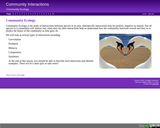
Introduction to community interactions for AP Biology.
- Subject:
- Biology
- Life Science
- Material Type:
- Lesson
- Author:
- Deb Henry
- Date Added:
- 03/19/2018

Introduction to community interactions for AP Biology.

Series of videos that can be used in an AP Biology Labs class created by Paul Anderson- Bozeman Science
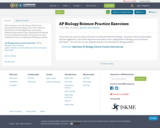
These exercises cover the Science Practices for Advanced Placement Biology. They were written by Julie Zedalis and John Eggebrecht, and include alignment information to the College Board AP Biology Course and Exam Description. The exercises are also available directly in the OpenStax AP Biology textbook.
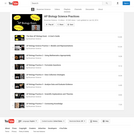
Paul Anderson's video play list of videos that can be used in a AP Biology Science Practices course

Series of videos that can be used in a AP Biology Video Essentials class created by Paul Anderson- Bozeman Science
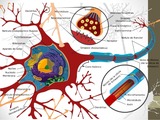
Anatomy and Physiology Lab I slide decks created by Steven Lee M.S. Pathology, FTCC. The PowerPoints include labeled body images to assist students in identifying body parts. Nicole Shaw is only responsible for assisting Steven with licensing his work under an open license and uploading content to the Commons.
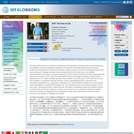
The goal of this lesson is to introduce students who are interested in human biology and biochemistry to the subtleties of energy metabolism (typically not presented in standard biology and biochemistry textbooks) through the lens of ATP as the primary energy currency of the cell. Avoiding the details of the major pathways of energy production (such as glycolysis, the citric acid cycle, and oxidative phosphorylation), this lesson is focused exclusively on ATP, which is truly the fuel of life. Starting with the discovery and history of ATP, this lesson will walk the students through 8 segments (outlined below) interspersed by 7 in-class challenge questions and activities, to the final step of ATP production by the ATP synthase, an amazing molecular machine. A basic understanding of the components and subcellular organization (e.g. organelles, membranes, etc.) and chemical foundation (e.g. biomolecules, chemical equilibrium, biochemical energetics, etc.) of a eukaryotic cell is a desired prerequisite, but it is not a must. Through interactive in-class activities, this lesson is designed to spark the students’ interest in biochemistry and human biology as a whole, but could serve as an introductory lesson to teaching advanced concepts of metabolism and bioenergetics in high school depending on the local science curriculum. No supplies or materials are needed.

In this seminar you will read closely and analyze the structure of ATP- Adenosine Triphosphate. You will curate your own information about the importance of ATP in a cell by listening and reading text as to what the experts have to say. By modeling the function of ATP in an inquiry lab you can accurately identify the various levels of cellular work done by Adenosine Triphosphate.StandardsBIO.A.3.1.1 Describe the fundamental roles of plastids (e.g., chloroplasts) and mitochondria in energy transformations.BIO.A.3.2.1 Compare and contrast the basic transformation of energy during photosynthesis and cellular respiration.BIO.A.3.2.2 Describe the role of ATP in biochemical reactions
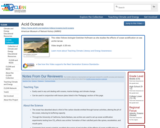
This video follows biologist Gretchen Hofmann as she studies the effects of ocean acidification on sea urchin larvae.
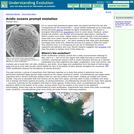
It's no secret that greenhouse gases warm the planet and that this has dire consequences for the environment whole islands swallowed up by rising seas, animal and plant species stressed by higher temperatures, and upsets in ecological interactions as populations move to cooler areas. However, carbon dioxide has another, less familiar environmental repercussion: making the Earth's oceans more acidic. Higher levels of carbon dioxide in the atmosphere mean that more carbon dioxide dissolves in the ocean. This dissolved carbon dioxide forms carbonic acid the same substance that helps give carbonated beverages their acidic kick. While this process isn't going to make the ocean fizzy anytime soon, it is introducing its own set of challenges for marine organisms like plankton and coral.

In this video segment, the ZOOM cast demonstrates how to use cabbage juice to find out if a solution is an acid or a base.

An alternative introduction to the chapter "Adapting and Living Together" - explained with Vamipres! It sits within the Ecology and Environment topic of the virtual school GCSE Biology. Teachers can choose which engagement video is better for their own uses and students.

Learn about how organisms adapt to their habitats. This video is part of The Virtual School's "Adapting and Living Together" chapter within our Ecology and Environment topic.
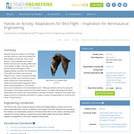
This activity first asks the students to study the patterns of bird flight and understand that four main forces affect the flight abilities of a bird. They will study the shape, feather structure, and resulting differences in the pattern of flight. They will then look at several articles that feature newly designed planes and the birds that they are modeled after. The final component of this activity is to watch the Nature documentary, "Raptor Force" which chronicles the flight patterns of birds, how researchers study these animals, and what interests our military and aeronautical engineers about these natural adaptations. This activity serves as an extension to the biomimetics lesson. Although students will not be using this information in the design process for their desert resort, it provides interesting information pertaining to the current use of biomimetics in the field of aviation. Students may extend their design process by using this information to create a means of transportation to and from the resort if they chose to.

An introduction to the chapter "Adapting and Living Together" within the Ecology and Environment topic of the virtual school GCSE Biology.
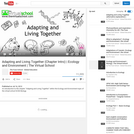
An introduction to the chapter "Adapting and Living Together" within the Ecology and Environment topic of the virtual school GCSE Biology.
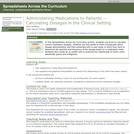
Spreadsheets across the Curriculum Module. Students build a spreadsheet to calculate proper medicine dosages using the metric system.
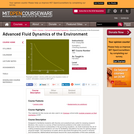
Theoretical topics of fluid dynamics relevant to natural phenomena or man-made hazards in water and atmosphere. Basic law of fluid motion. Scaling and approximations. Slow flows, with applications to drag on a particle and mud flow on a slope. Boundary layers: jets and plumes in pure fluids or in porous media. Thermal and buoyancy effects, selective withdrawal and internal waves. Transient boundary layers in impulsive flows or waves. Induced streaming and mass transport. Dispersion in steady flows or in waves. Effects of earth rotation on coastal flows. Wind induced flow in shallow seas. Stratified seas and coastal upwelling.
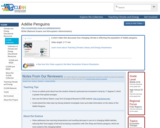
A short video that discusses how changing climate is affecting the population of AdÃlie penguins.

As taught Semesters 1 and 2, 2011
This learning object compares and contrasts afferent and efferent nerves of the peripheral nervous system.
This learning object is used as part of the level 1 Biological Sciences module delivered by the School of Nursing, Midwifery and Physiotherapy.
Andy Meal – lecturer in Biological Sciences, School of Nursing, Midwifery and Physiotherapy, University of Nottingham.